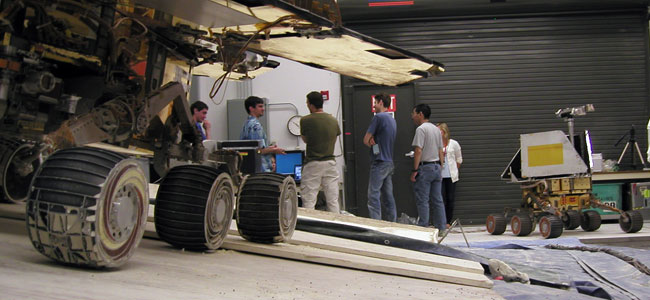Dust Storm Adds Urgency to Mars Rover Predicament

Dust storms are currently stirring up the Martian skies inthe region where NASA's Spirit rover is stuck in the sand. The swirling sandsdon't pose an immediate threat to Spirit, but they could create more urgencyfor the effort to free the mired rover if dust obscures her access to solarenergy.
Spirit has been stuck inMartian dirt up to its hubcaps since May 6, when it became mired in a dirtpatch (now called "Troy") while driving backward.
Engineers back on Earth have been using working replicas ofthe rover to test out waysto maneuver Spirit out of the sand trap.
So far, time has been on the team's time, as Spirithas plenty of energy ever since her solar arrays got cleaned off by winds a fewmonths ago.
There's no immediate threat to Spirit's power levels from adarkened, dust-filled sky, as the rover has plenty of reserves and roverhandlers are being conservative with their energy use, said project managerJohn Callas. But when the winds abate, they may have a problem, as the dustwill then start falling back to the Martian surface.
"If the dust is raining out of the skies, it will buildback up on the solar arrays," Callas said. This could become a problemduring the next Martian winter, when the sun is low in the sky and generally makingit difficult to keep power supplies up.
The dust should start falling out in a matter of days, andthough scientists can only estimate how much dust has been whipped up into theatmosphere, "it does seem like there's a lot of dust in the air,"Callas said.
Breaking space news, the latest updates on rocket launches, skywatching events and more!
The dust storm won't have any effect on Spirit's dug in-position,Callas said. While the winds of the storm will push around dirt particles ?sometimes enough to obliterate rover tracks ? it only amounts to "a verythin veneer of surface material," Callas told SPACE.com.
Callas and his team are still using the replica rovers totest out scenarios for moving Spirit, which they plan to start doing inSeptember.
The team is using two different test rovers ? a heavier,engineering model that has all the same instruments as Spirit and its twin, Opportunity, and a lighter model that more accurately simulates the weight of the rovers inMars' lower gravity. The pair of rovers have been on Mars for morethan five years now.
The engineers are also trying out rover moves in twodifferent types of sand: one lighter, flour-like material that represents a"worst-case scenario" because it provides little traction, and onecoarser material that represents a "best-case scenario" because ithas more bearing strength and provides more traction, Callas explained.
With the data from testing both rovers in both types ofmaterial, the rover engineers will have a better idea of what might work beston Mars. In a week or so, they'll do a dress rehearsal, in which they move oneof the test rovers all the way through the sequence that's planned for use onMars.
If the test goes well, they'll try the maneuvers out withSpirit herself.
The potential dust deposits increase the urgency of gettingSpirit out, Callas said, because if her solar arrays become blocked, they'llhave to find a good winter haven ? and the sooner the better.
"We all want to get out; we all want to get movingagain," Callas said.
- SPACE.com Video Show - Rover Tracks on Mars
- The Most Amazing Mars Rover Discoveries
- Video - Spirit: The Little Rover That Could

Andrea Thompson is an associate editor at Scientific American, where she covers sustainability, energy and the environment. Prior to that, she was a senior writer covering climate science at Climate Central and a reporter and editor at Live Science, where she primarily covered Earth science and the environment. She holds a graduate degree in science health and environmental reporting from New York University, as well as a bachelor of science and and masters of science in atmospheric chemistry from the Georgia Institute of Technology.
